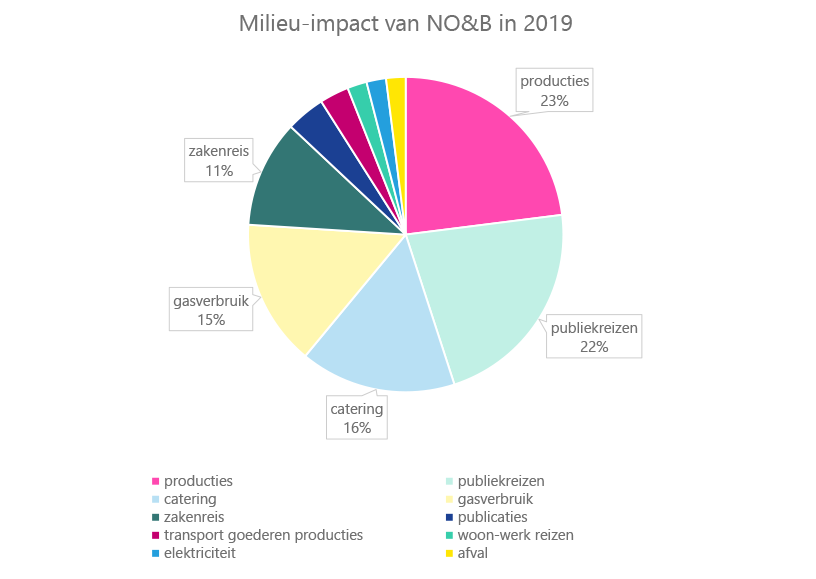
The shift towards low-carbon art
DUTCH NATIONAL OPERA & BALLET’S CARBON FOOTPRINT
You cannot start your sustainability journey unless you know where you stand. That is why Dutch National Opera & Ballet (DNO&B) had its carbon footprint calculated in 2022*. Julie Fuchs, Sustainability Coordinator, elaborates.
To Julie Fuchs, one of the biggest surprises about DNO&B’s carbon footprint was that the glass soft drink bottles that are sold in the foyer are less sustainable than plastic bottles. ‘That’s very unexpected, wouldn’t you say?’, says Fuchs. ‘We’re trying to cut back on single-use plastics, which is why we opted for glass bottles. But because glass is much heavier than plastic, it’s more climate unfriendly, for instance in terms of transport. And if that glass is single-use too, it takes more energy and is more expensive to produce than plastic.’ All in all, calculating the carbon footprint is a rather complex exercise.

By calculating their carbon footprint, organisations get an idea of their energy consumption and greenhouse gas emissions. You cannot reduce your emissions unless you know what your emissions are and where they are coming from. In the calculation process, an organisation’s gas and electricity consumption, employee commuting and business travel are converted into carbon equivalents. Other more unexpected factors, such as purchased products, are also included. This results in a snapshot of the organisation’s indirect emissions.
High emissions
DNO&B has much to gain in terms of reducing its indirect emissions. Fuchs: ‘In 2019, we established that, after our productions, our catering purchases (both for the foyer and events, and for the staff cafeteria) and audience travel were our largest sources of emissions, followed by gas consumption and business travel.’ Audience travel might seem an outlier on this list, but because people specifically travel to and from the theatre to see a performance, it has a place in the calculation.
Low emissions
But DNO&B scored better than expected on some aspects as well. Fuchs: ‘I always buy refurbished laptops and phones myself, because I know that these devices have a large climate footprint. But purchases of new hardware for DNO&B accounted for only 0.8% of total carbon emissions. That’s pretty low. Employee commuting added up to just 2% of total emissions. I’d expected that to be a lot higher. It turns out that many of our people cycle to work or commute by public transport.’
Now that DNO&B knows more about the nature of its emissions, it can make plans to reduce its footprint. Fuchs: ‘We’re working hard on the circularity of our productions by recapturing materials and we’ve changed the food & beverage offering in the artists foyer. We’ve switched to online meetings where possible and we travel less. But we can do better still. We also want to encourage international artists to travel to Amsterdam by train if at all feasible.’
Utilities
Given that the City of Amsterdam owns the building at Waterlooplein, the City is a key partner in DNO&B’s sustainability effort. The heating installations were replaced in 2018 to reduce the theatre’s gas bill. Fuchs: ‘We’ve teamed up with the City to change all lighting to LED and sustainability is now a key driver in each change that is made to and around the building.’
DNO&B’s other building, the Production Workshop, which is located in Amsterdam-Zuidoost, is gas-free. Fuchs: ‘That building is hooked up to district heating. The fly tower has been outfitted with solar panels, which generate 40% of the building’s annual electricity requirement. Also, both our buildings are powered with green electricity from Dutch solar and wind parks.’
Glass or plastic?
So, will the glass soft drink bottles be replaced by plastic ones in the near future? Fuchs: ‘We don’t know yet. We’re currently selling organic juice from Dutch producers in glass bottles. Because the juice is locally sourced, the associated carbon emissions are lower. But we’ll definitely be having a conversation about these dilemmas with our suppliers.’
* The carbon footprint calculation was performed by a specialist agency, which followed the Greenhouse Gas Protocol.
Text: Anne Havelaar



